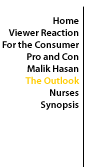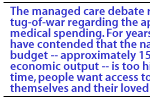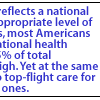 |




If you focus strictly on the enrollment numbers, it would be easy to believe
that managed care is enjoying its greatest prosperity ever. The Minneapolis
research firm of InterStudy recently tallied a
record 70 million Americans who get their health care from the best-known type
of managed care plan, the HMO, or health maintenance organization. That is more
than the number of people who regularly watch or who eat at
McDonalds, or who voted for Bill Clinton in 1996. With HMO enrollment climbing
11% a year, it isn't hard to envision the day when more than 100 million
Americans will belong to such plans.
Formats of HMOs vary widely, but they all share a few crucial traits. They
deliver health insurance to the public at relatively affordable prices -- on
the condition that members deal exclusively with a pre-selected network of
doctors and hospitals. Those medical panels are meant to provide cost-effective
care that meets the HMO's own quality standards. HMOs traditionally have been
keen advocates of preventive care, such as flu shots, cholesterol checks and
cancer screenings. At the same time, though, HMOs usually have tried to reduce
frequencies of surgeries, hospitalizations and some expensive prescription-drug
usage, on the belief that those services are widely overused.
|  |
| 
For all their rapid expansion, HMOs like the ones featured on FRONTLINE's
"The High Price of Health" have a long way to go before they become
America's favorite way of getting medical care. According to a recent survey by
Robert Blendon at the Harvard School of Public Health, some 48% of Americans
say they personally have experienced problems with HMOs' care, or have close
friends or relatives who have run into such difficulties. Complaints include
difficulty getting access to medical specialists, problems with emergency care,
and excessive red tape when trying to file grievances or appeals.
Some of that public indignation is spilling into the political arena --
leading to calls for tighter regulation of HMOs. Since 1996, at least two dozen
states have taken action against the perceived excesses or flaws of managed
care. Consumers' groups and the medical lobby are calling for enactment of
additional bills, both at the state and federal level. One of the most sweeping
initiatives in the U.S. Congress is the Patient Access to Responsible Care Act,
introduced by Rep. Charlie Norwood, a Georgia Republican and licensed dentist
who argues: "If we can protect trees and animals, why can't we
protect patients?"
|  |
|
Not surprisingly, the managed-care industry is fighting what it perceives as
potential over-regulation that could undermine its ability to save money on
health care. The HMO industry's main trade association, the American
Association of Health Plans has denounced the Norwood
bill in particular, suggesting that it could push up the cost of health care to
the point that millions of Americans would be forced to go without medical
insurance. Political analysts believe that managed-care reform will remain a
hot issue in Congress and state legislatures for at least the next several
years, with lawmakers trying to find compromise language that will satisfy
consumers' and doctors' groups without offending insurers and the corporate
employers who pay most health-care premiums.
Fundamentally, the debate about managed care reflects a national tug-of-war
regarding the appropriate level of medical spending. For years, most Americans
have contended that the national health budget -- approximately 14% of total
economic output -- is too high. Yet at the same time, people want access to
top-flight care for themselves and their loved ones. That image of quality
includes not just sheer medical competence, but also the chance to be a
special patient, getting care in convenient settings with
considerable personal attention.
As a result, top executives of America's HMOs sometimes find themselves caught
in the middle. If they obey the call for national austerity, they are bombarded
with patients' requests for exceptions, and are widely portrayed as stingy and
unfeeling. If they go in the other direction and accommodate all of members'
wishes, health plans find they must charge sky-high premiums, or operate at a
loss. Malik Hasan, the featured HMO leader in The High Price of
Health, has been one of the corporate chieftains most willing to talk
publicly about these tensions. But the chief executive of Kaiser Permanente
confided in a Wall Street Journal interview at the end of 1997 that the
stresses associated with his job have risen greatly in recent years. Kaiser,
the oldest and largest HMO in the United States, reported its largest-ever loss
for 1997, running a deficit of $270 million, as costs grew unexpectedly rapidly
and premiums failed to keep up.
In the short run, the HMO industry is trying to restore financial stability by
raising prices. In the mid-1990s, HMOs made some people think that they had
vanquished medical inflation -- as rates to big employers increased just 0.5%
to 2% a year. But the managed care plans "paid dearly for
competitive pricing in 1997," says John Erb, a benefits consultant at William
M. Mercer Inc. "Many lost money and margins were slim for most of the rest. Corporate employers
surveyed by Mercer at the start of 1998 said they are budgeting for 7% rate
increases in their health care costs this year. While that isn't as steep as
the double-digit boosts of the 1980s, it does suggest that HMOs haven't been
able to slow down medical costs as much as they once hoped.
This vexing news for consumers, of course, is seen in a brighter light by the
investment community. Many HMOs are for-profit, publicly traded companies, and
their stocks have surged in the early months of 1998. The financial advisory
firm of Sherlock Co. found that HMO shares, on
average, climbed more than 15% in January and February 1998, recouping some of
their underperformance of the previous year.
What remains to be seen, though, is just how much extra Americans are willing
to spend for better healthcare. The Kaiser Family Foundation
recently reported an all-too-telling survey of
Americans' ambivalent attitudes on these issues. Some 1,200 people across the
country were asked if they supported the types of reforms included in most
pending HMO bills. As much as 80% to 90% of respondents initially said they
wanted to see pro-consumer safeguards such as better appeal rights and easier
access to specialists. Then respondents were asked if they would be willing to
have health care premiums increase a few dollars extra each month to achieve
such measures. Favorable responses dropped below 50%. When pollsters asked if
people would stomach premium increases of $15 a month or higher, barely
one-quarter of the public still had an appetite for reform.
Those numbers suggest that for the next few years, managed care may be a lot
like the Southern California freeways -- a system that no one really likes, but
that everyone puts up with.
|  |